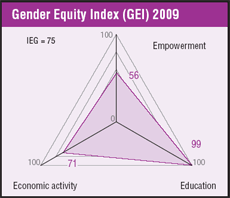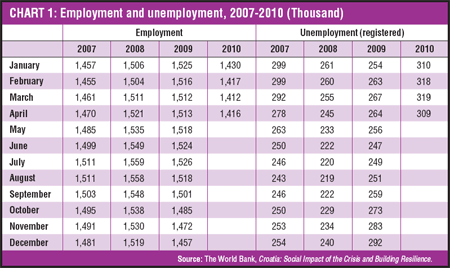An uncertain scenario
Inge Perko-Šeparovic, PhD
Kristina Babic
Croatian Law Centre
A lack of up-to-date and reliable data makes it difficult to determine the extent to which poverty in Croatia is deepening as a consequence of the economic crisis, but indicators suggest that the 2009 recession reversed recent improvements in the social sphere, making it hard to rein in the country’s growing pauperization. Circumstances are thus more and more unfavourable for the realization of Millennium Development Goal 1 on poverty eradication. The Government’s belief that it is possible to reduce poverty and inequality while at the same time embracing the neoliberal agenda has proven not only unrealistic but also imprudent.
 |
The years 2001–2009, the period considered for this report, cover almost two thirds of the time allotted for the realization of the Millennium Development Goals (MDGs). Data on Croatia’s gross domestic product (GDP) during these years show an annual increase of about 4.4% until 2008, when this decreased for the first time to 2.4%. It then dropped dramatically by 5.8% in 2009.[1] Foreign debt as the main source of additional funds needed for public spending increased on average by 12.5% annually over the same period,[2] while the growth in public expenditure was 6.7% in 2008 and 2.3% in 2009. This has only contributed to the deepening of the crisis.
Increasing poverty
Although GDP per capita rose from HRK 25.538 (USD 4.474) in 2001 to HRK 45.379 (USD 7.951) in 2009,[3] this had almost no influence on the poverty rate during the same period. As the economic and financial crisis began to unfold, 2008 already showed signs of regression in the poverty indicators. The Gini coefficient – the measure of income inequality developed by the World Bank – went up from 0.28 in 2007 to 0.29 in 2008 and the quintile ratio, which compares the total equivalent income of the upper and lower quintile (20% of the richest and 20% of the poorest), from 4.3 in 2007 to 4.6 in 2008.
Due to lack of available data at the time of writing, the poverty rate for 2009 can only been presented based on simulations done by the World Bank; the exact data for this variable are due to be published by the Central Bureau of Statistics (CBS) in October 2010. The simulations of short-term changes in poverty between 2008 and 2009 show an increase in relation to spending of 3.5 percentage points. The share of households living below the accepted poverty line of USD 380 per adult increased from 10% in 2008 to 13.5% in 2009.[4] The largest increase in vulnerability, from 5.3% to 15.8%, occurred in households with two or more children.[5] Thus in a single year the 2009 recession nullified recent social improvements.
Between 2005 and 2008 economic development and the new jobs linked to it led to the opening of new workplaces and the reduction of unemployment. In that period poverty was primarily linked to long-term unemployment and inactivity, mostly concentrated among low-qualified workers. The rate of poverty risk in 2008 was highest for the unemployed at 32.6%. However the job loss caused by the economic crisis meant the number of registered unemployed in January 2010 was 20% more than the previous year. The reduction in employment, the decrease in real income (in relation to the index of consumer prices) and the pay freeze in the public sector have pushed many people into poverty. The “new” poor person differs from the “old” one in that he/she is better-educated, younger, economically active, more often male, works in manufacturing and lives in the economically more developed regions.[6]
 |
Social transfers
Social transfers can be defined in both a broad or narrow sense. Narrowly defined, in accordance with the Eurostat definition, they encompass income related to unemployment, maternity leave, care benefits for newborns, child allowances, benefits for sick leave lasting longer than 42 days, benefits for bodily injuries and care of others, social benefits, benefits for rehabilitation and employment of people with disabilities, disability pensions, schooling stipends and housing benefits. Social transfers in a narrow sense are related to benefits awarded to individuals in cash as opposed to services (e.g., free health care) or material goods.
Social transfers should be effective and efficient in addressing the risk of poverty so that they have a significant redistribution effect and thus reduce the poverty rate. In this regard, public expenditures directed to social benefits have produced the greatest reductions.
The CBS has not yet adopted the Eurostat methodology for the collection of data on expenditures for social protection and social transfers. For instance, the category “other liquid receipts” in the questionnaire on household spending is most similar to the Eurostat’s category of social transfers, although it also contains the variable “family pension”.
Spending on social transfers and economic growth stabilized the poverty rate in the first part of the period under review, although its effect on reducing social inequality was insignificant. The lack of complete and reliable data for 2009 and the uncertainty regarding the situation in which Croatia will be at the end of 2010 make it impossible to present a total picture of the impact of the crisis. Still there are many indicators that it will be substantial and that circumstances will be more and more unfavourable for the effective realization of the goal of poverty eradication. The growing pauperization will be difficult to control.
All the factors in play – the drop in GDP combined with the growth of debt and public expenditure – make it clear that dramatic budget cuts are required. The rebalancing of the budget for 2010 has been delayed and the question is where the cuts will be made. They should certainly not be in the area of social transfers, which are needed to help alleviate the increasingly difficult situation of beneficiaries.
The budget line for unemployment benefits in 2009 was amended three times: on 9 April when the planned amount of USD 150 million was increased by some USD 20 million; on 18 July when USD 42 million were added; and on 3 August when the amount was reduced by around USD 22 million (due to a reduction in unemployment as a result of seasonal employment). The budget line for cash benefits to citizens and households was amended accordingly: the planned amount of USD 68.6 million was increased by 10% with the first amendment, then increased again by USD 3 million and finally reduced by USD 228.500. These examples show that the Government did a poor job of preparing for the crisis and did not devise proper measures to tackle it. The lack of foresight found the country poorly equipped to respond and reacting on an ad hoc basis.
Conclusion
Croatia has entered a long tunnel and recovery will be neither quick nor simple. Knowledge, skills and courage are all needed to choose the right policies and the instruments and measures to efficiently implement, monitor and evaluate them. Whether social problems can be effectively solved with ad hoc measures is doubtful. The optimum use of available means in conditions of ever increasing constraints is vital to successfully overcome the crisis and simultaneously reduce poverty.
The answer to the question of whether Croatia will be able to succeed without renouncing the dominant neoliberal paradigm has to be in the negative. To believe that it is possible to reduce poverty and inequality while at the same time embracing the neoliberal agenda is both unrealistic and foolish.
[2] Ibid.
[3] Croatian National Bank, “General information on Croatia – economic indicators.” Available from: <www.hnb.hr/statistika/e-ekonomski_indikatori.htm>.
[4] The World Bank, Croatia: Social Impact of the Crisis and Building Resilience, 10 June 2010, 38–39. Available from: <go.worldbank.org/SPXPLMBLM0>.
[5] Ibid.
[6] Ibid.


